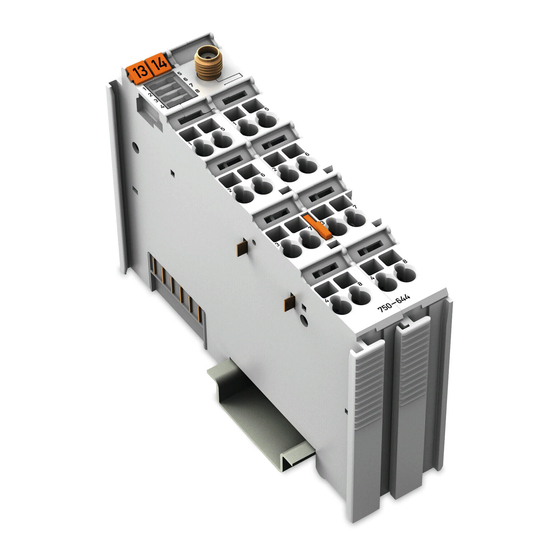
WAGO I/O System 750 Quick Start Manual
Fieldbus independent i/o modules, bluetooth rf transceiver
Hide thumbs
Also See for I/O System 750:
- Manual (468 pages) ,
- Quickstart reference (54 pages) ,
- Product manual (28 pages)
Table of Contents

Summary of Contents for WAGO I/O System 750
- Page 1 Fieldbus Independent I/O Modules ® Bluetooth RF Transceiver 750-644 Quick Start Version 1.0.1...
- Page 2 2 • General Copyright © 2008 by WAGO Kontakttechnik GmbH & Co. KG All rights reserved. WAGO Kontakttechnik GmbH & Co. KG Hansastraße 27 D-32423 Minden Phone: +49 (0) 571/8 87 – 0 Fax: +49 (0) 571/8 87 – 1 69 E-Mail: info@wago.com...
-
Page 3: Table Of Contents
Modules............9 ® 2.2.1 Configuration of the Bluetooth Slave Using "Net Forming"..... 9 ® 2.2.2 Configuration of the Bluetooth Master Using "Net Forming" ..13 2.2.3 Process Data Allocation..............15 Testing the Process Data Exchange............16 WAGO-I/O-SYSTEM 750 I/O Modules... -
Page 4: Important Comments
All other changes to the hardware and/or software and the non-conforming use of the components entail the exclusion of liability on part of WAGO Kon- takttechnik GmbH & Co. KG. -
Page 5: Symbols
Additional Information References for additional literature, manuals, data sheets and web pages. 1.3 Number Notation Number Code Example Note Decimal normal notation Hexadecimal 0x64 C notation Binary '100' within inverted commas, '0110.0100' nibble separated with dots WAGO-I/O-SYSTEM 750 I/O Modules... -
Page 6: Safety Notes
Do not use any contact spray. The spray may impair the functioning of the contact area. The WAGO-I/O-SYSTEM 750 and its components are an open system. As such, the system and its components must be installed in appropriate hous- ings, cabinets, enclosures or in electrical operation rooms. Access must only be provided via key or tool to authorized, qualified personnel. -
Page 7: Quick Start
If you are using one PC with two ports, the WAGO-I/O-CHECK software can be started several times. You can select the proper COM ports using the "F8" key on your keyboard. If using only one port or one WAGO-I/O- CHECK, the configuration of master and slaves is rather time-consuming. - Page 8 8 • Quick Start Network Structure Figure 1: Hardware configuration g064461e WAGO-I/O-SYSTEM 750 I/O Modules...
-
Page 9: Starting Up The Bluetooth
® 2.2.1 Configuration of the Bluetooth Slave Using "Net Forming" 1. Start the WAGO-I/O-CHECK software (Version 3 or later). 2. Click on the [Identify] button. Your node configuration is graphically displayed (see Figure 2). Figure 2: Identify your node configuration g064462e ®... - Page 10 6. Enter (if not already set) a process image size of 48 bytes and a mailbox size of 12 bytes (see Figure 4). Figure 4: Data structure g064444e 7. Click on the [Read] button in the toolbar to update the view of the con- figuration in the module. WAGO-I/O-SYSTEM 750 I/O Modules...
- Page 11 9. Choose the option All in the area Search for accessible devices and click ® on the [Search] button to search the network for Bluetooth devices in the environment. To limit the search results to WAGO devices of the 750 se- ries, choose WAGO 750. ® The MAC addresses of all found Bluetooth devices are displayed in the list of devices within range (see Figure 5).
- Page 12 16. Under navigation in the Operation Mode field, choose the real-time mode using the [Communication (Realtime)] button. 17. Proceed as in section 2.2.2 to create a link from the side of the master as well (Master ! Slave). WAGO-I/O-SYSTEM 750 I/O Modules...
-
Page 13: Configuration Of The Bluetooth
Starting up the Bluetooth® Modules ® 2.2.2 Configuration of the Bluetooth Master Using "Net Forming" 1. Start the WAGO-I/O-CHECK software (Version 3 or later). 2. Click on the button [Identify]. Your node configuration is graphically displayed. ® 3. Click with the right mouse button on the Bluetooth module that you would like to configure as a master. - Page 14 9-12). They may then be stored using "Drag & Drop", for example, from the search results into the list of authorized devices (slots 1…13). However, for safety reasons, WAGO devices are hidden for search request in communi- cation operating mode; they may also be entered like other hidden devices or inaccessible devices: 10.
-
Page 15: Process Data Allocation
3. In the navigation, choose the menu item PI Mapping. The process data allocation is loaded from the module and graphically dis- played in WAGO-I/O-CHECK. 4. Move the ruler for the first slave to the right so that the first slave is as- signed the maximum possible number of bytes in the master's process im- age (see Figure 8). -
Page 16: Testing The Process Data Exchange
+ 2 (bytes 0 and 1 are reserved for status information) ® 6. Test whether the input data of the one Bluetooth module lead to the cor- ® rect output data of the second Bluetooth module. WAGO-I/O-SYSTEM 750 I/O Modules... - Page 17 Quick Start • 17 Testing the Process Data Exchange WAGO-I/O-SYSTEM 750 I/O Modules...
- Page 18 WAGO Kontakttechnik GmbH & Co. KG Postfach 2880 • D-32385 Minden Hansastraße 27 • D-32423 Minden Telefon: 05 71/8 87 – 0 Telefax: 05 71/8 87 – 1 69 E-Mail: info@wago.com Internet: http://www.wago.com...












Need help?
Do you have a question about the I/O System 750 and is the answer not in the manual?
Questions and answers